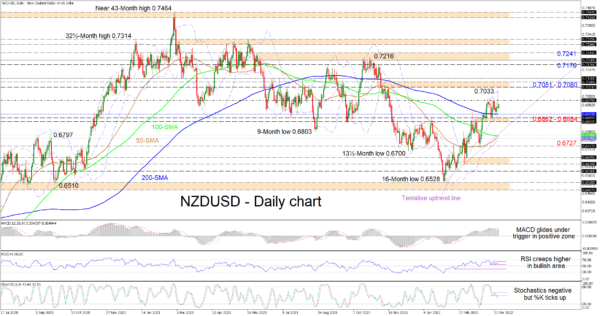NZDUSD’s upside momentum has softened above the simple moving averages (SMAs) after a persisting two-month uptrend spiked toward the upper Bollinger band at 0.7033. The negative slopes of the longer-term 200- and 100-day SMAs have eased, while the upturn in the 50-day SMA and its bullish crossover of the 100-day SMA reaffirms that the near-term uptrend from the 0.6528 trough is strengthening.
The short-term oscillators are conveying that the recent weakness in upside momentum may be short lived. The MACD, in the positive region, has slipped slightly beneath its flattened red trigger line, while the RSI has started to renew a positive bearing in the bullish section. Furthermore, the negative charge of the stochastic oscillator looks shaky as the upturn in the %K line is transmitting messages of growing positive drive.
If the pair recovers from yesterday’s weakness, an initial step above the 0.6979 barrier could push buyers to test the upper Bollinger band at 0.7033 before tackling the 0.7051-0.7080 resistance band linked to the levels from November 2021. Now, should the bulls repower the recent uptrend by piloting beyond the 0.7100 handle too, the pair may then navigate towards the 0.7176 high prior to confronting the 0.7200-0.7241 resistance barricade, which involves highs from June and October 2021.
Otherwise, if bullish drive struggles to improve further, downside constraints may commence from the 200-day SMA at 0.6903 and the mid-Bollinger band ahead of the 0.6862-0.6884 support border, which is reinforced by a tentative uptrend line pulled from the 16-month low of 0.6528. In the event sellers manage to drive the price below this critical section and the diagonal support, the bears could then aim for a zone of support linking the converged 50- and 100-day SMAs around 0.6788 and the lower Bollinger band at 0.6770. From here, pushing lower, the key 0.6727 trough from March 15 may draw focus.
Summarizing, NZDUSD is sustaining a bullish bias above the SMAs, the mid-Bollinger band and the 0.6862-0.6884 minor foundation. That said, a dive in the price past the 0.6727 trough could ramp up worries about negative tendencies.















